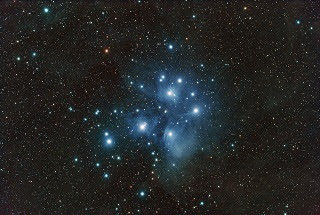I write space opera because I find astronomy and cosmology fascinating. How was
our planet created? How did the solar system come to be? How did the universe start?
I'm not special in that respect. Humans have looked at the stars and asked
questions since forever.
 |
| The Pleiades |
The aboriginal people in
Australia thought the stars of the Milky Way (the band of light we see crossing
the night sky) was a river marked by the campfires along its length. They have a
story about the Pleiades, the open cluster near the constellation Orion. The
aboriginal people called them the Seven Sisters, just as we do. You can read the legend here.
Basically, seven sisters are pursued by a hunter who wants one of them as his
wife. The Greeks had their own very similar legend in which Orion chases the
daughters of Atlas. The aboriginal story and the Greek story are remarkably
similar, and I find that fascinating, since there's no way one version could have influenced the other. This link takes you to more stories about the
Pleiades.
Ancient people explained natural events in ways that made sense to them. But as we became more knowledgeable, we could explain something like the Pleiades in more and more depth. However, there's something deliciously... RIGHT... about the ancient interpretation. The stars of the Pleiades are, you might say, stellar sisters. And the hunter in the sky is Orion. As Professor Olivia Jhutta (main character in The Stuff of Legend) explains, "legends often arise around a kernel of truth".
Ancient people explained natural events in ways that made sense to them. But as we became more knowledgeable, we could explain something like the Pleiades in more and more depth. However, there's something deliciously... RIGHT... about the ancient interpretation. The stars of the Pleiades are, you might say, stellar sisters. And the hunter in the sky is Orion. As Professor Olivia Jhutta (main character in The Stuff of Legend) explains, "legends often arise around a kernel of truth".
I really enjoyed writing The
Stuff of Legend. The plot centers around an open cluster called the Maidens
or the Dancers and the legends that relate to it. The constellation is not the Pleiades or any
other particular open cluster but it's based on reality.
I did my research and found out
that globular clusters are tightly packed (for stars) and gravitationally bound
to each other. The stars are the oldest we know of, and because of that
wouldn't be likely to have the elements created in super novas so they're not
likely to include second Earths. The stars in open clusters are younger. They
form in the usual stellar nurseries like the gas clouds of the mighty Orion
Nebula. From there, they remain in a more 'open' gravitational relationship
until they leave home on their own. Our sun was probably part of an open
cluster when it was a teenager. You can find out more about open
clusters here.
For the purposes of my story I
wanted the gas clouds that you see around Orion as part of the legends
associated with my cluster. I went back to research, and discovered that an
open cluster that had been thought to be part of the Orion Nebula, was in fact
a different entity, situated in front of the nebula. Here's the story of NGC 1980. It was
perfect. So my story takes place with regard to a star cluster that has some
similarities to NGC 1980.
When history professor Olivia Jhutta receives a distress call from her parents, she sets out into space with their business partner, her grandmother and injured Confederacy Admiral Jak Prentiss to find them. But she’s not the only one interested in the Jhutta’s whereabouts. The Helicronians believe Olivia’s parents have found an ancient weapon which they can use to wage war on the Confederacy.
Jak goes on the trip to fill in time while he’s on enforced leave, helping Olivia follow cryptic clues in what he considers an interplanetary wild goose chase in search of a fairy story. But as the journey progresses and legend begins to merge with unsettling fact, Olivia and Jak must resolve their differences and work together if they are to survive. The two are poles apart… but it’s said opposites attract. If they can manage to stay alive.
Buy the book: Amazon iBooks Kobo B&N GooglePlay
Or buy from Payhip and get 20% off. Use coupon code G4U677DOVK
Space Opera/ Science Fiction Romance. Features non-humanoid aliens and some non-specific sex scenes. There’s action adventure and politics.



Fascinating blog! I love stories that include legends, especially when they contain backstory about how the legend evolved or what inspired them. The Pleiades have certainly been especially important to many cultures.
ReplyDeleteThere's lots about where the legend came from in this book. It was so much fun to write.
ReplyDeleteCool! It's fun to write legends into our sci-fi stories, bringing history into the future and giving them a new twist.
ReplyDelete